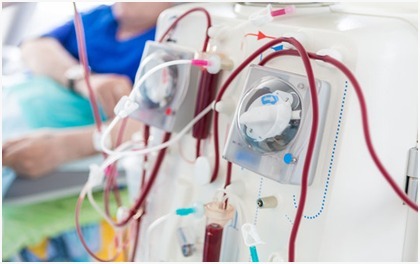
Chronic Kidney Disease (CKD) has emerged as a significant public health problem in India, with a dramatic increase in the number of cases over the past few years. The kidneys are essential to maintain the electrolyte balance in the body and thereby regulating the blood pressure through the process of filtering out the waste and excess fluids from the blood. When these functions are compromised, it leads to kidney disease, a condition that can have severe consequences if not managed appropriately. Once correctly diagnosed, CKD cannot be cured by any treatment. It is progressive kidney disease and invariably progresses to End Stage Kidney Disease (ESKD) irrespective of the cause of initial injury. Retardation of progression of CKD and delaying the need for dialysis and/or renal replacement therapy (RRT) is one of the main purposes of conservative management of CKD.
A number of factors, including an ageing population, changing lifestyles and increase in non- communicable diseases like diabetes and hypertension, have contributed to a rapid rise in the prevalence of the disease. The causes of CKD are Diabetes Mellitus (commonest cause responsible for 35-40% CKD patients), Hypertension (second commonest cause responsible for around 15% CKD patients), Glomerulonephritis (responsible for around 15% CKD patients), Tubulo-interstitial diseases of Kidney (responsible for around 15% CKD patients), other kidney diseases, UTI etc. Life-style modifications like weight control, avoid tobacco, regular exercise, balanced healthy diet and monitoring of hyperlipidemia, blood sugar, blood pressure and cardiovascular diseases is very important to prevent and control of CKDs. Unfortunately, as the disease remains asymptomatic in the initial stages, it makes early diagnosis difficult. As the diagnosis of large percentage of cases does not occur at an early stage, most often, the illness has advanced to a point where it necessitates expensive, time-consuming treatment like dialysis or kidney replacement. This is because early identification of the disease becomes difficult. However, kidney transplantation is considered as the best-outcome option for kidney failure.
Growing Burden of Kidney Disease:
Globally, Chronic Kidney Diseases (CKD) is emerging as a serious public health concern. It has heightened from 17th place to 12th place during the time span of 1990 to 2017 (27 years) as the major cause of death. Overall, Chronic kidney disease (CKD) affects 13.4% of the world’s population. According to a cross-sectional study conducted by the International Society of Nephrology’s Kidney Data Centre (ISN- KDDC) to assess the CKD and cardiovascular risk in 12 countries including India, the prevalence was found to be 14.3% in the general population and 36.1% in the high-risk groups. Further, talking about the global all-age mortality rate due to CKD between 1990 and 2017, the estimates rose by approximately 41·5%.
As per the Indian Council of Medical Research (ICMR), 2017 report titled “India: Health of the Nation’s States”, has ranked CKD as ninth leading cause of death in India. It went from being ranked 30th in 1990 to the 20th rank in DALY in 2016, demonstrating an increasing prevalence of CKD. The Indian adult population now has a 7.1% prevalence of diabetes, and 28% of people over 40 who live in cities have the disease, according to data from the Indian Council of Medical Research.
Deaths due to renal failure constituted 2.9% of all deaths in India during 2010–13 among 15–69 year old age group. Even today, over 90% of patients requiring Renal Replacement Therapy (RRT) in India die because of inability to afford care, and even in those who do start RRT, 60% stop for financial reasons.
Government Initiatives:
Recognizing the gravity of the situation, the Government of India has implemented various initiatives to address the rising incidence of kidney disease and improve the overall healthcare infrastructures. The efforts of the government may be summarized under the following programs and schemes as below:
● National Programme for Prevention and Control of Non-Communicable Diseases (NP-NCD)
Erstwhile NP-NCD was known as National Programme for Prevention and Control of Cancer, Diabetes, Cardiovascular Diseases, and Stroke (NPCDCS). Kidney disease is closely linked to conditions like diabetes and hypertension. The NP-NCD, launched by the Government of India, aims to prevent and control these non-communicable diseases, by focusing on strengthening of infrastructure, human resource development, health promotion & awareness generation, screening, early diagnosis, management and early referral for treatment of NCDs including CKD.
● Pradhan Mantri National Dialysis Programme (PMNDP):
Recognizing the financial burden on individuals undergoing dialysis, the government initiated the PMNDP to provide affordable dialysis services. Under this scheme, dialysis centers are being established across the country, providing dialysis services at the district hospitals in the country, free of cost to all BPL beneficiaries, ensuring that more people have access to this life-saving treatment. PMNDP has been implemented in total 36 States/UT in 748 (25 Linked) Districts at 1515 centers by deploying 10505 Hemodialysis machines. Total 24.53-lakh patient availed dialysis services and 287.47 Lakh Hemodialysis sessions were held as on 31 July 2024.
● Ayushman Bharat – Pradhan Mantri Jan Arogya Yojana (AB-PMJAY):
Government launched AB- PMJAY as one of the world’s largest healthcare schemes that covers tertiary and secondary hospitalization, including those related to kidney diseases. AM-PMJAY now provides financial protection to over 120 million families and 550 million individuals (as on December 2023). The treatment packages under the scheme are very comprehensive including all drugs and diagnostic services. This helps in ensuring that families do not face catastrophic healthcare expenditures in achieving their health goals.
The scheme offers a health insurance coverage of Rs. 5 lakh per family per year for secondary or tertiary care hospitalization, extended to over 12 Crores beneficiary families identified from Socio Economic and Caste Census 2011 (SECC 2011) database.
● Pradhan Mantri Swasthya Suraksha Yojna (PMSSY):
Treatment regarding NCDs including CKD are provided to all the patients at various health facility level like Medical Colleges, Central Institutes like AIIMS, Central Government hospitals, and private sector empanelled hospitals under the health care delivery system through PMJAY and State-based schemes.
- Pradhan Mantri Bhartiya Janaushadhi Pariyojana (PMBJP):
Government of India is establishing the Affordable Medicines and Reliable Implants (AMRIT) pharmacy stores at various hospitals/institutions in collaboration with the State Governments. The programme seeks to provide medications at a significant savings over the Maximum Retail Price, enabling everyone to access high-quality generic medications at reasonable costs. As on 30.06.2024 under PMBJP, 12,616 Janaushadhi Kendras are functional in the country and 2047 medicines and 300 surgical items.
- National Organ Transplant Programme:
The government has been actively promoting organ transplantation as a viable treatment option for end-stage kidney disease. Efforts are being made to streamline organ donation and transplantation processes, creating a more conducive environment for both donors and recipients.
- Ayushman Arogya Mandir:
The Government of India is strengthening the primary healthcare system by transforming sub-health centers and primary health centers into Ayushman Arogya Mandirs. These centers are essential in providing preventive, promotive, and basic healthcare services, including screening for early signs of kidney disease. 1,74,141 Ayushman Arogya Mandirs (AAMs erstwhile HWCs) and 29,016 Primary Health Centers (PHCs) are envisaged to deliver expanded range services that go beyond Maternal and child health care services to include care for non communicable diseases, palliative and rehabilitative care, Oral, Eye and ENT care, mental health and first level care for emergencies and trauma , including free essential drugs and diagnostic services.
Challenges and the Way Forward:
Lack of awareness, limited knowledge, shortage of specialists, and high treatment costs, undoubtedly contribute to disparities in accessing treatment. These challenges affect not only low and middle-income countries but also certain high-income settings. Despite these commendable efforts in India, challenges persist in addressing the growing burden of kidney disease. Awareness campaigns are crucial to educate the public about risk factors, early symptoms, and preventive measures. Additionally, a focus on research and innovation is essential to develop cost- effective intervention and treatment.
Conclusion:
The overall situation of kidney disease in India underscores the importance of a multi-pronged approach, involving prevention, early detection, and accessible treatment options. The Government of India’s initiatives, such as NP-NCD, PMNDP, AB-PMJAY, and others, are steps in the right direction. Utilizing telemedicine and digital platforms can bridge the gap in healthcare access; especially during times of crisis. Continued collaboration between government bodies, healthcare professionals, and the public is necessary to effectively tackle the challenges posed by kidney disease and improve the overall health outcomes of the population.
[The author is Sr. Chief Medical Officer of NCVBDC, Dte.GHS,MoHFW,GoI & Ex-DDG (NCD)]




